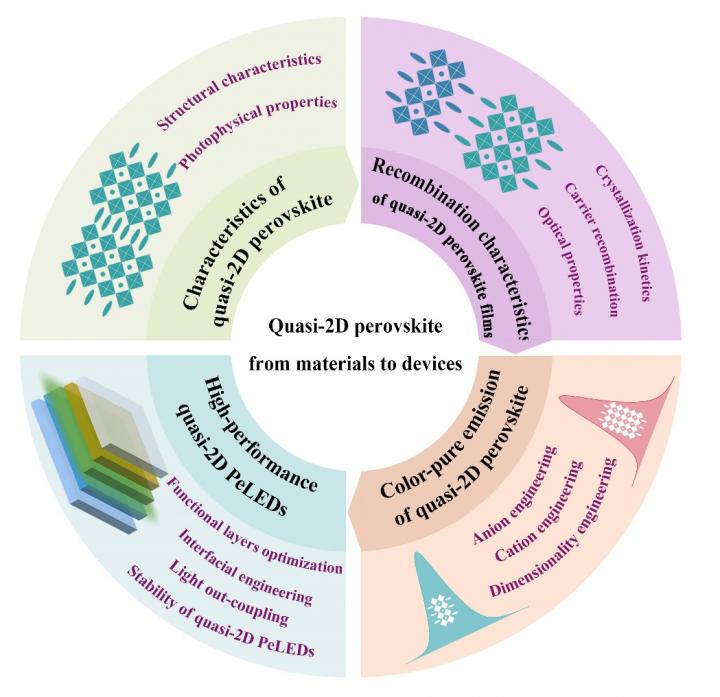
Credit: by Li Zhang, Changjiu Sun, Tingwei He, Yuanzhi, Junli Wei, Yanmin Huang and Mingjian Yuan
Light-emitting diodes (LEDs) are changing the lighting and display industry and have obtained significant advances than traditional lighting sources. The traditional materials LEDs, e.g., III-V semiconductor LEDs, organic LEDs (OLEDs) and quantum-dot LEDs (QLEDs), have achieved great success and gradually realized commercialization, but still face some challenges. The OLEDs have the low carrier transport capability and exciton recombination, which would hinder the improvement of brightness. Besides, QLEDs show challenges for the tedious manufacturing process and the reliance on hydrophobic insulating long ligands also hinders their stability and electrical conductivity.
Compared with these traditional materials, quasi-2D perovskites represent an important category of perovskites, which possess the self-assembled multi-quantum-well structures, have gained great success in light emission applications thanks to their outstanding optoelectrical properties. However, the performance and stability of quasi-2D PeLEDs still can’t meet the requirement for commercialization at the moment. More efforts need to be devoted further to explore the optical and electrical properties of these materials. Besides, the investigation of the correlation between device performance and underlying photophysics of the materials appears to be particularly important.
In a new review article published in Light Science & Application, a team of scientists, led by Professor Mingjian Yuan from Key Laboratory of Advanced Energy Materials Chemistry (Ministry of Education), Renewable Energy Conversion and Storage Center (RECAST), College of Chemistry, Nankai University, China, and co-workers have presented an overview of the inherent properties of quasi-2D perovskite materials, the corresponding energy transfer and spectral tunability methodologies in thin films, as well as their application in high performing LEDs. They then summarized the challenges and potential research direction towards developing high-performance and stable quasi-2D PeLEDs.
Quasi-2D perovskites possess the natural quantum-well structures, which can induce both dielectric- and quantum- confinements. These strong confinements thus afford large exciton binding energy (Eb). The robustness of the excitonic states at room temperature is the most prominent optical feature for quasi-2D perovskites, which originates from their large Eb. Fortunately, Eb can be regulated through composition and structure engineering. The large Eb and thus prominent excitonic luminescence are unique features of quasi-2D perovskites application for LEDs.
In addition, quasi-2D perovskite films feature with a mixed-phase rather than a single-phase because the formation energies for different quasi-2D phases are quite similar. During the photo-excitation, the photo-carriers transfer from higher bandgap species to lower bandgap species rapidly and efficiently, leading to the accumulated carriers in the recombination center. The resulting high carrier density thus partially photo-passivates the shallower trap states, herein significantly avoids trap-mediated nonradiative recombination to take place. Therefore, the energy transfer facilitates the radiative recombination, resulting in high PLQYs for quasi-2D perovskite films even at low pumping density.
Quasi-2D perovskite can achieve the emission from violet to NIR spectral region by adjusting the chemical composition and dimensionality engineering. However, the realization of high-performance pure red and blue quasi-2D PeLEDs, which can conform to the most advanced Recommendation BT 2020 (Rec. 2020) standard demands the monochromatic RGB primaries, still encounters many obstacles. They summarized three promising strategies, including: (1) Anion engineering; (2) Cation engineering; (3) Dimensionality engineering, to achieve highly performed pure red and blue quasi-2D PeLEDs.
Highly emissive perovskite layers are not sufficient to obtain high-performance quasi-2D PeLEDs, due to the photoluminescence-electroluminescence gap. They summarized three aspects to improve the electric properties in quasi-2D PeLEDs, including function layers modulation, interfacial engineering, and light out-coupling technologies. In addition, operational stability is another critical parameter of quasi-2D PeLEDs and we then overview several possible reasons for the degradation.
Finally, they discussed the perspectives for future development of novel quasi-2D perovskite materials/structures, white-light-emitting quasi-2D devices and the potential applications of quasi-2D perovskite emitters in large-area, printable, and flexible electronics as well as quasi-2D perovskite lasers, aiming to shed light on these promising future perspectives.
###
Media Contact
Mingjian Yuan
[email protected]
Related Journal Article
http://dx.




